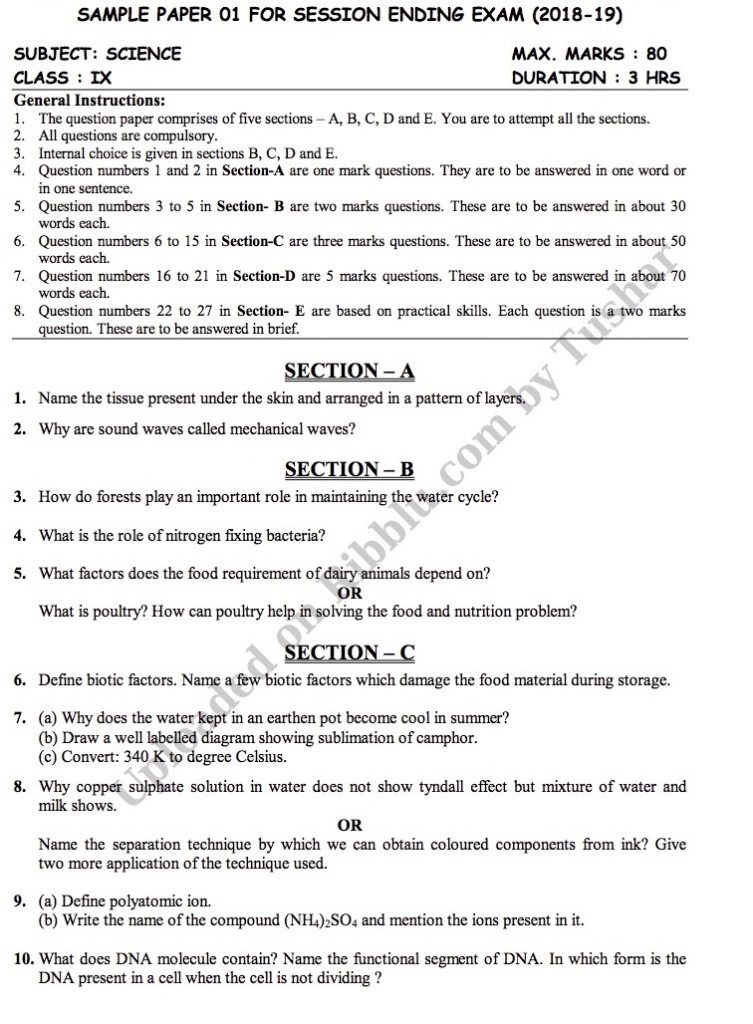The best way to prepare apart from completing NCERT and reference books is solving CBSE Sample Papers.On Ribblu you will find Latest CBSE Sample Papers for Class 9 Science in PDF as per CBSE | NCERT and KVS pattern. Both unsolved and solved sample papers have been uploaded by various students and teachers and are as per latest Class 9 Science syllabus, blueprints of 2021. Students must download and practice to get better marks in exams. .
Download Free Printable CBSE guess papers, model papers test papers for Class 9 Science along with marking scheme, by practicing these papers you will understand the pattern of questions which will be asked in the exams and prepare accordingly. The Class 9 Science sample papers cover each and every important topic and help all students to score higher marks. All aspiring students are required to attempt these kind of Sample Question papers in examination conditions at home which will help them to get familiarised with how to write in exams. The mock papers for Class 9 Science have been drafted based on the latest structure released.
Science Sample Papers for Class 9
These sample papers will help students in achieving maximum marks in their exams. By attempting These Papers students gain confidence and get ready to face their school examinations. These sample papers, worksheets and Summative Assessment papers are school wise and covers important concepts from an examination perspective. Students and parents can download all the available papers & worksheets directly in the form of PDF.
CBSE Class 9 Science Solved Sample Paper (10) – 2020
CBSE Class 9 Science Solved Sample Paper (9) – 2020
CBSE Class 9 Science Solved Sample Paper (8) – 2020
CBSE Class 9 Science Solved Sample Paper (7) – 2020
CBSE Class 9 Science Solved Sample Paper (6) – 2020
CBSE Class 9 Science Solved Sample Paper (5) – 2020
CBSE Class 9 Science Solved Sample Paper (4) – 2020
CBSE Class 9 Science Solved Sample Paper (3) – 2020
CBSE Class 9 Science Solved Sample Paper (2) – 2020
CBSE Class 9 Science Solved Sample Paper (1) – 2020
CBSE Class 9 Science Sample Paper (4) – 2019
CBSE Class 9 Science Sample Paper (3) – 2019
CBSE Class 9 Science Sample Paper (2) – 2019
CBSE Class 9 Science Sample Paper (1) – 2019
CBSE Sample Papers For Class 9 Science (10)
CBSE Sample Papers For Class 9 Science (9)
CBSE Sample Papers For Class 9 Science (8)
CBSE Sample Papers For Class 9 Science (7)
CBSE Sample Papers For Class 9 Science (6)
CBSE Sample Papers For Class 9 Science (5)
CBSE Sample Papers For Class 9 Science (4)
CBSE Sample Papers For Class 9 Science (3)
CBSE Sample Papers For Class 9 Science (11)
CBSE Sample Papers For Class 9 Science (12)
CBSE Sample Papers For Class 9 Science (2)
CBSE Sample Papers For Class 9 Science (1)

Sample Papers of Other Subjects of Class 9
CBSE Sample Papers of Class 9 Mathematics
CBSE Sample Papers of Class 9 English
CBSE Sample Papers of Class 9 Social Science
CBSE Sample Papers of Class 9 Hindi
CBSE Sample Papers of Class 9 French
CBSE Class 9 Science Previous Year Question Papers
CBSE Class 9 Science Test Papers, Unit Tests and Periodic Assessment Exams
CBSE Class 9 Science Question Bank and Important Questions Chapter wise
Before beginning the preparation of Class 9 Science by attempting Sample Papers, one needs to follow few steps and procedures in order to improve the performance in CBSE examination. At Ribblu we recommend few steps
1- Analysis of Syllabus of Class 9 Science : To begin with students needs to analyse the full Syllabus of Science for Class 8 which is drafted by school as per guidelines issued by CBSE and NCERT for upcoming Examination. By analysing students come to understanding the details about all topics and the mark weightage for each chapter and topic of Science .
2- Complete NCERT Science Book of Class 9: After understanding the syllabus, you need books to start preparing for Exams. At NCERT website you can find NCERT Books for Class 8 Mathematics, which are free to download in pdf format.
3- Extra Study Materials for Class 9 Science : Few more things that students need for better performance in Exams are Revision Notes, Worksheets, Extra Questions, MCQs and HOTs for Class 9 Science
5- Solve Previous Year Question Papers for Class 9 Science : Here on ribblu.com students can also find previous years Question papers for Class 9 Science with solutions for better understanding of exam patterns and help in revision of the entire course.
On Ribblu one can find Study Materials and Educational content which is shared by students , teachers and parents based on the latest Curriculum of CBSE and NCERT.
Solving Latest year 2021 Sample Papers for Class 9 Science is the best option to get into perfect examination condition and prepare for Class 9 exams. By solving Class 9 Science Sample Papers issued by CBSE one get full understanding of the pattern of examination paper and thus increase knowledge of how to address the questions given in the question papers and also focus on all important topics which are again and again asked in exams. Students should take support of parents to create exam like conditions at home and solve these 2021 sample papers for Science .
Term-wise Syllabus Session-2021-22
Class-IX Subject: Science (086)
Term-I (April 2021 to September 2022)
UNIT-I Matter-Its Nature and Behaviour
Chapter -1: Matter in our surroundings
Definition of Matter: Solid, liquid and gas; Characteristics –Shape, Volume, Density; change of state – melting (Absorption of heat), freezing, evaporation (Cooling by evaporation), Condensation, Sublimation.
Chapter-2: Is Matter Around Us Pure:
Elements, Compound and mixtures. Heterogeneous and homogeneous mixtures, colloids and suspension.
UNIT-II Organisation in the Living World:
Chapter-5:The Fundamental Unit Of Life
Cell as a basic unit of life; Prokaryotic and Eukaryotic cells, multicellular organisms, cell membrane and Cell Wall, Cell Organelles and Cell inclusions; Chloroplast, Mitochondria, Vacuoles, Endoplasmic reticulum, Golgi apparatus; Nucleus, Chromosomes –basic structure, number.
Chapter- 6: Tissues
Structure and functions of animal and plant tissues (only four types of tissues in animals, meristematic and permanent tissues in plants)
UNIT-III – Motion, Force and Work
Chapter-8: Motion
Distance and displacement, velocity, uniform and non-uniform motion along a straight line, acceleration, distance- time and velocity- time graphs for uniform motion and uniformly accelerated motion, Derivation of equations of motion by graphical method, elementary idea of uniform circular motion.
Chapter-9: Force and Laws of Motion:
Force and motion, Newton’s Laws of Motion, Action and reaction forces, Inertia of body, Inertia and mass, Momentum, force and acceleration. Elementary idea of conservation of momentum.
UNIT-II – Organisation in the Living World
Chapter-7: Diversity In Living Organism
Diversity of plants and animals – basic issues in scientific naming, basis of classification. Hierarchy of categories/groups, major groups of plants (salient features) (Bacteria, Thallophyta, Bryophyta, Pteridophyta, Gymnosperm and Angiosperms). Major groups of animals (salient features) (Non Chordates upto Phylum and Chordates upto class).
UNIT V-FOOD PRODUCTION
Chapter-15: Improvement In Food Resources
Plant and animal breeding and selection for quality improvement and management; use of fertilizers and manures; Protection from Pests and diseases, organic farming.
Term –II (October 2021 to March 2022)
UNIT III – MOTION, FORCE AND WORK
Chapter-10:Gravitation
Gravitation, Universal law of Gravitation, Force of Gravitation of earth (gravity), Acceleration due to gravity; Mass and weight, Free fall.Floatation: Thrust and pressure, Archimedes’ principle, Buoyancy, Elementary idea of Relative density.
UNIT IV – OUR ENVIRONMENT
Chapter-14:Natural Resources
Physical resources: Air, Water, Soil, Air for respiration, for combustion, for moderating temperatures; movements of air and its role in bringing rains across India. Air, water and soil pollution (brief introduction). Holes in ozone layer and the probable damages. Biogeochemical cycles in nature: Water, Oxygen, Carbon and Nitrogen
UNIT I – Matter – Its Nature and Behavior
Chapter-3: Atoms And Molecules
Particle nature, basic units: Atoms and molecules, Laws of chemical combination. Chemical formula of common compounds,Atomic and molecular masses, mole concept; Relationship of mole to mass of the particles and numbers.
UNIT II – Organisation in the Living World
Chapter-13: Why Do We Fall ill
Health and Diseases: Health and its Failure, Infectious and Non-infectious diseases, their causes and manifestation, Diseases caused by microbes(virus, bacteria and protozoans) and their prevention, principles of treatment and prevention. Pulse Polio programs and Immunization
UNIT III – MOTION,FORCE AND WORK
Chapter-11: Work and Energy
Work done by a force, Energy, Power, Kinetic and Potential energy; Law of conservation of energy.
Chapter-12: Sound
Nature of sound and its propagation in various media, speed of sound, range of hearing in humans, ultrasound, reflection of sound; Echo and SONAR, Structure of Human ear (Auditory aspect only)
Practicals
1. Preparation of:
- a true solution of common salt, sugar and alum
- a suspension of soil, chalk powder and fine sand in water
- a colloidal solution of starch in water and egg albumin/milk in water and distinguish between these on the basis of transparency filtration criterion stability
2. Preparation of:
- a mixture
- a compound using iron filings and sulphur powder and distinguish between these on the basis of:
- i. appearance, i.e., homogeneity and heterogeneity
- ii. behaviour towards a magnet
- iii. behaviour towards carbon disulphide as a solvent
- iv. effect of heat
3. Separation of the components of a mixture of sand, common salt and ammonium chloride (or camphor).
4. Performing the following reactions and classifying them as physical or chemical changes :
- Iron with copper sulphate solution in water
- Burning of magnesium in air
- Zinc with dilute sulphuric acid
- Heating of copper sulphate
- Sodium sulphate with barium chloride in the form of their solutions in water
- Preparation of stained temporary mounts of (a) onion peel, (b) human cheek cells & to record observations and draw their labeled diagrams.
6. Identification of Parenchyma, Collenchyma and Sclerenchyma tissues in plants, striped, smooth and cardiac muscle fibers and nerve cells in animals from prepared slides. Drawing of their labeled diagrams.
7. Determination of the melting point of ice and the boiling point of water.
8. Verification of the Laws of reflection of sound.
9. Determination of the density of solid (denser than water) by using a spring balance and a measuring cylinder.
10. Establishing the relation between the loss in weight of a solid when fully immersed in
- tap water
- strongly salty water, with the weight of water displaced by it by taking at least two different solids.
11.Determination of the speed of a pulse propagated through a stretched string / slinky.
12. Study of the characteristics of Spirogyra / Agaricus, Moss / Fern, Pinus (either with male or female cone) and an
Angiospermic plant. Drawing and providing two identifying features of the groups they belong to.
13. Observing the given pictures / charts / models of earthworm, cockroach, bony fish and bird. For each organism,
drawing of their picture and recording:
- one specific feature of its phylum.
- one adaptive feature with reference to its habitat.
- Verification of the law of conservation of mass in a chemical reaction.
14. Study of the external features of root, stem, leaf and flower of monocot and dicot plants.
